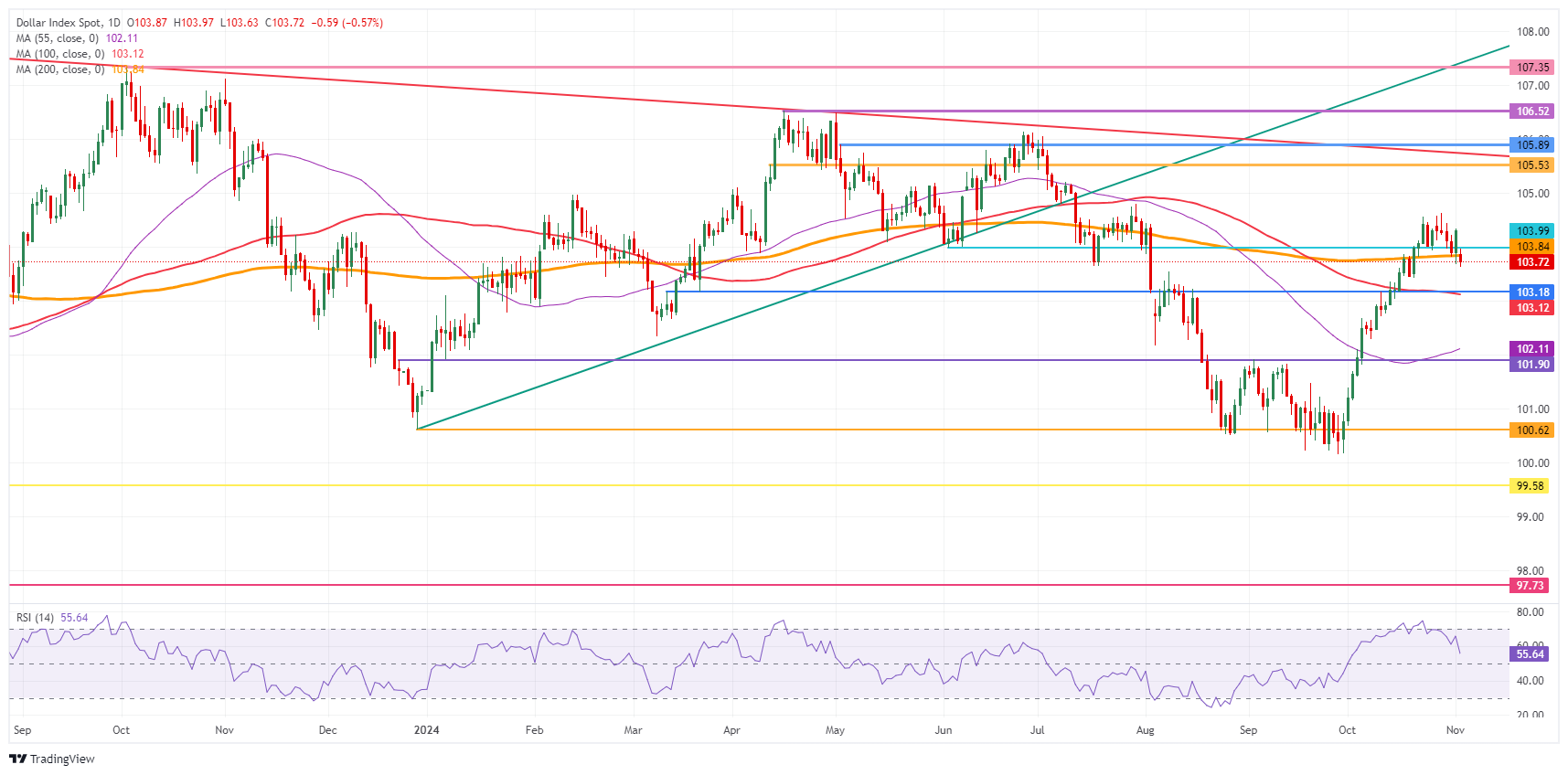- The US Dollar in red figures on Monday after Ipsos polls project Vice President Kamala Harris taking the lead in the US presidential elections.
- Traders set for a very volatile week, with the Fed meeting amidst US presidential election uncertainty.
- The US Dollar index slides below 104.00 and is looking for support.
The US Dollar (USD) sees Friday's gains being erased and dips lower on all fronts on Monday, after a final poll publication from ABC News and Ipsos showed Vice President Kamala Harris leading by 49% against 46% for former President Donald Trump. Another element for more US Dollar weakness comes from The New York Times, which released data pointing that Harris is ahead in five of the seven swing states that will determine the outcome of the US presidential election.
The US economic calendar, meanwhile, needs to be considered as well with a very interesting element ahead this Monday: the Senior Loan Officer Opinion Survey (SLOOS) for the third quarter. The report will tell more on the conditions, supply and demand of loans extended to customers in the US. Loan distribution is a very good leading indicator to sketch how the economy will evolve in the coming weeks and months.
Daily digest market movers: Be on the lookout for headlines as of now
- Several analysts and strategist from several big banks are releasing their outlook and reports on the US presidential election outcome this week. Main theme several are reporting on, is that it might take days, even weeks until the actual 60th US President will be known with former US President Donald Trump having filed several court cases in key swing states on election fraude, Reuters reports.
- On Sunday night, the final poll from ABC News and Ipsos showed Vice President Kamala Harris leading by a 49%-46% edge nationally. The New York Times/Siena survey showed Harris being ahead in five of the seven swing states.
- Factory Orders for September came out roughly in line of expectations, with a contraction by 0.5%, against the -0.4% against the previous decline of 0.2%.
- The Senior Loan Officer Opinion Survey (SLOOS) for the third quarter will be published at 19:00 GMT.
- Chinese equities are very happy with the positive Harris polls and have closed in the green on Monday. European equities and US equity futures are still looking for direction.
- The CME FedWatch Tool is backing a 25 basis point (bps) interest-rate cut on Thursday’s meeting with a 99.7% probability against a marginal 0.3% chance of rates remaining stable.
- The US 10-year benchmark rate trades at 4.29%, lower than the 4.38% where it closed on Friday.
US Dollar Index Technical Analysis: Aligned
The US Dollar Index (DXY) is set to enter a rough patch of volatility this week, so precautionary measures are needed when trading the US Dollar. Expect to see massive swings, mostly headline driven with even possibly unclear direction and rapid moves days after the election. Bigger levels – such as 102.11 on the downside and 105.53 on the upside – need to be considered as possible outcomes.
The DXY has given up two key levels on Monday and needs to regain control of those two levels first, before considering recovering toward 105.00 and higher. First up is the 200-day Simple Moving Average (SMA) at 103.84 together with the 104.00 big figure. The second element is the high of last week at 104.63.
On the downside, the 100-day SMA at 103.12, together with the pivotal level at 103.18 (high from March 12) are the first line of defence. In case of rapid and volatile moves this week, rather look for 101.90 together with the 55-day SMA at 102.11 to consider as a substantial support level. In case that level snaps, an excursion below 101.00 could be possible.
US Dollar Index: Daily Chart
Employment FAQs
Labor market conditions are a key element to assess the health of an economy and thus a key driver for currency valuation. High employment, or low unemployment, has positive implications for consumer spending and thus economic growth, boosting the value of the local currency. Moreover, a very tight labor market – a situation in which there is a shortage of workers to fill open positions – can also have implications on inflation levels and thus monetary policy as low labor supply and high demand leads to higher wages.
The pace at which salaries are growing in an economy is key for policymakers. High wage growth means that households have more money to spend, usually leading to price increases in consumer goods. In contrast to more volatile sources of inflation such as energy prices, wage growth is seen as a key component of underlying and persisting inflation as salary increases are unlikely to be undone. Central banks around the world pay close attention to wage growth data when deciding on monetary policy.
The weight that each central bank assigns to labor market conditions depends on its objectives. Some central banks explicitly have mandates related to the labor market beyond controlling inflation levels. The US Federal Reserve (Fed), for example, has the dual mandate of promoting maximum employment and stable prices. Meanwhile, the European Central Bank’s (ECB) sole mandate is to keep inflation under control. Still, and despite whatever mandates they have, labor market conditions are an important factor for policymakers given its significance as a gauge of the health of the economy and their direct relationship to inflation.
Information on these pages contains forward-looking statements that involve risks and uncertainties. Markets and instruments profiled on this page are for informational purposes only and should not in any way come across as a recommendation to buy or sell in these assets. You should do your own thorough research before making any investment decisions. FXStreet does not in any way guarantee that this information is free from mistakes, errors, or material misstatements. It also does not guarantee that this information is of a timely nature. Investing in Open Markets involves a great deal of risk, including the loss of all or a portion of your investment, as well as emotional distress. All risks, losses and costs associated with investing, including total loss of principal, are your responsibility. The views and opinions expressed in this article are those of the authors and do not necessarily reflect the official policy or position of FXStreet nor its advertisers. The author will not be held responsible for information that is found at the end of links posted on this page.
If not otherwise explicitly mentioned in the body of the article, at the time of writing, the author has no position in any stock mentioned in this article and no business relationship with any company mentioned. The author has not received compensation for writing this article, other than from FXStreet.
FXStreet and the author do not provide personalized recommendations. The author makes no representations as to the accuracy, completeness, or suitability of this information. FXStreet and the author will not be liable for any errors, omissions or any losses, injuries or damages arising from this information and its display or use. Errors and omissions excepted.
The author and FXStreet are not registered investment advisors and nothing in this article is intended to be investment advice.
Recommended content
Editors’ Picks

EUR/USD remains offered and challenges 1.0800
The intense recovery in the US Dollar keeps the price action in the risk complex depressed, forcing EUR/USD to recede further and put the key support at 1.0800 to the test on Friday.

GBP/USD breaks below 1.2900 on stronger Dollar
Persistent buying pressure on the Greenback has pushed GBP/USD to multi-day lows below the 1.2900 level, as investors continue to digest the recent interest rate decisions from both the Fed and the BoE.

Gold meets support around the $3,000 mark
The combined impact of a stronger US Dollar, continued profit taking, and the effects of Quadruple Witching weighed on Gold, pulling its troy ounce price down to around the pivotal $3,000 level on Friday.

US SEC Crypto Task Force to host the first-ever roundtable on crypto asset regulation
The US Securities and Exchange Commission (SEC) Crypto Task Force will host a series of roundtables to discuss key areas of interest in regulating crypto assets. The “Spring Sprint Toward Crypto Clarity” series’ first-ever roundtable begins on Friday.

Week ahead – Flash PMIs, US and UK inflation eyed as tariff war rumbles on
US PCE inflation up next, but will consumption data matter more? UK budget and CPI in focus after hawkish BoE decision. Euro turns to flash PMIs for bounce as rally runs out of steam. Inflation numbers out of Tokyo and Australia also on the agenda.

The Best brokers to trade EUR/USD
SPONSORED Discover the top brokers for trading EUR/USD in 2025. Our list features brokers with competitive spreads, fast execution, and powerful platforms. Whether you're a beginner or an expert, find the right partner to navigate the dynamic Forex market.
